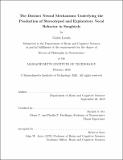The distinct neural mechanisms underlying the production of stereotyped and exploratory vocal behavior in songbirds
Author(s)
Lynch, Galen(Galen Forest)
Download1237146929-MIT.pdf (47.49Mb)
Other Contributors
Massachusetts Institute of Technology. Department of Brain and Cognitive Sciences.
Advisor
Michale S. Fee.
Terms of use
Metadata
Show full item recordAbstract
Whether it is speaking to one another, or nailing a tennis serve, humans can perform an incredible range of behaviors, most of which are learned. How do we and other animals learn complicated sequential behaviors, and once they are learned how are they executed? This thesis is an investigation into the neural basis of the two modes of behavior that occur at the beginning and end of learning a motor skill: the initially highly variable exploratory behavior, and the ultimately stereotyped skilled performance. To understand the start and end points of learned motor behaviors, I present two studies, each on the premotor activity of ensembles of neurons that underlie song production in zebra finches. Executing learned motor behaviors requires animals to produce precisely timed motor sequences. While cortical motor regions traditionally have been viewed as encoding features of motor gestures (Georgopoulos et al., 1982), more recent studies have suggested that motor regions may have intrinsic dynamics to pattern the production of motor gestures (Churchland et al., 2012). A similar debate has arisen in songbirds. Adult birdsong requires the premotor nucleus HVC (used as a proper noun), in which projection neurons burst sparsely at stereotyped times in the song. It has been hypothesized that projection neuron bursts, as a population, form a continuous sequence, while a different model of HVC function proposes that HVC activity is tightly organized around motor gestures. Using a large dataset of HVC neurons recorded in singing birds, we test several predictions of these models. We find that projection neuron bursts in adult birds are continuously and nearly uniformly distributed throughout song. Another model posits that LMAN may act as an excitable media producing locally propagating waves of activity, and predicts that all nearby pairs of neurons would be highly correlated. To test these models and to understand how LMAN actively generates behavioral variability, we built a miniature lightweight microdrive to simultaneously record from multiple neurons, as well as a lightweight endoscope to perform functional calcium imaging of ensembles of LMAN neurons. With these new technologies, we observed the simultaneous activity of pairs of single units in singing juvenile and adult birds. We find that most pairs of neurons with small separation (<250 μm) are completely uncorrelated, which is incompatible with the wave model. However, a small subset of pairs have strikingly large correlations, with correlation coefficients of up to 0.81. Intriguingly, these correlated pairs of neurons can be separated by up to 400 μm. The existence of such highly correlated neurons within LMAN is inconsistent with LMAN being a simple balanced excitatory-inhibitory network with uniformly random connectivity. These results suggest that new models of variability generation are required to explain how LMAN generates exploratory behavioral variability.
Description
Thesis: Ph. D. in Neuroscience, Massachusetts Institute of Technology, Department of Brain and Cognitive Sciences, May, 2020 Cataloged from student-submitted PDF version of thesis. Includes bibliographical references (pages 213-232).
Date issued
2020Department
Massachusetts Institute of Technology. Department of Brain and Cognitive SciencesPublisher
Massachusetts Institute of Technology
Keywords
Brain and Cognitive Sciences.